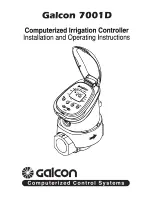
plete list of criteria prior to initiating the design of the
sprinkler system.
Questions concerning sprinkler installation and us-
age criteria which are not covered by the following in-
structions should be submitted to Star Sprinkler Inc.
Include sketches and technical details as appropriate.
In some instances, the requirements of this docu-
ment may concern specifications which are more
stringent and which take precedence over those
specified in NFPA 13, NFPA 13D, NFPA 13R, or by the
authority having jurisdiction.
The spray from the sprinkler is distributed radially
outward and downward from the sprinkler deflector.
Consequently, the sprinklers must be located such
that there will not be any blind spaces shielded from
spray by partitions, room dividers, overhangs or
other parts of the dwelling structure.
The number of sprinklers within each compartment
(as defined by NFPA 13, 13D, or 13R), must be kept
as few as possible. Do NOT use more sprinklers than
necessary to cover a particular space.
Use only the escutcheon provided with the Celeste
S220.
The sprinkler must be secured in position by firmly
fastening the sprinkler system piping to the struc-
ture. If the sprinkler is not properly secured in posi-
tion, reaction forces resulting from sprinkler opera-
tion could alter its orientation and its water
distribution pattern. The sprinkler escutcheon cannot
be used to hold the sprinkler in position.
General Service Conditions. The Celeste S220 must
only be utilized in wet pipe sprinkler systems.
Thermal Response Criteria. All residential sprinklers in-
stalled within a compartment (as defined by relevant
NFPA standards) must be of the same heat response ther-
mal characteristics, and their temperature ratings are to
be within 10°F (5.5°C) of each other.
Hydraulic Design Criteria. The minimum required single
and multiple sprinkler flow rates are given in Table A as a
function of temperature rating and the maximum allow-
able coverage areas. The single sprinkler flow rate is the
minimum required discharge from the most hydraulically
demanding single sprinkler and, the multiple sprinkler
STAR SPRINKLER INC.
Page 2
1-3.2.40
FIGURE 1
CELESTE S220 RESIDENTIAL
FLUSH PENDENT SPRINKLER
A
B
C
SPRINKLER
AREA
WRENCHING
TOLERANCE
CEILING LEVEL
LIMIT
FITTING
FACE OF
SPRINKLER
PROTECTIVE CAP
(27.8±4.8 mm)
1-3/32±3/16"
MOUNTING
SURFACE
9/32" (7.4 mm) TYP.
2-9/16" (65 mm) DIA.
IN OPERATED
POSITION
DEFLECTOR
29/32±3/16"
(23.0±4.8 mm)
2" (50 mm) DIA.
DO NOT
OVER-TIGHTEN
COLLECTOR
HEAT
(61.9 mm)
2-7/16"
NOMINAL MAKE-IN
7/16" (11.1 mm)
1/2" NPT
(a) For coverage area dimensions less than or between those
indicated, it is necessary to use the minimum required flow for
the next highest coverage area for which hydraulic design
criteria are stated.
(b) Requirement is based on minimum flow in GPM from each
sprinkler. The associated residual pressures are calculated
using the nominal K-factor. Refer to Hydraulic Design Criteria
Section for details.
TABLE A
HYDRAULIC DESIGN CRITERIA
12 x 12
MAXIMUM
COVERAGE
AREA
(a)
FT. x FT.
SINGLE
SPRINKLER
Minimum Flow
(b)
(Residual Pressure)
14 x 14
16 x 16
18 x 18
20 x 20
13 GPM
(11.1 PSI)
13 GPM
(11.1 PSI)
13 GPM
(11.1 PSI)
13 GPM
(11.1 PSI)
14 GPM
(12.9 PSI)
13 GPM
(11.1 PSI)
19 GPM
(23.7 PSI)
19 GPM
(23.7 PSI)
13 GPM
(11.1 PSI)
13 GPM
(11.1 PSI)
162°F
MULTIPLE
SPRINKLERS
Minimum Flow
(b)
(Residual Pressure)
162°F
OBSOLETE
























